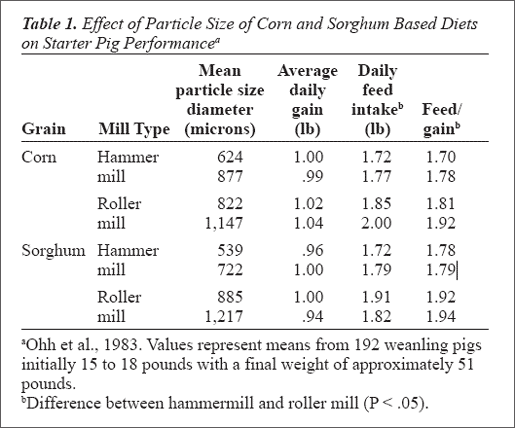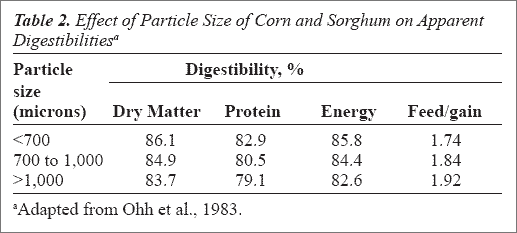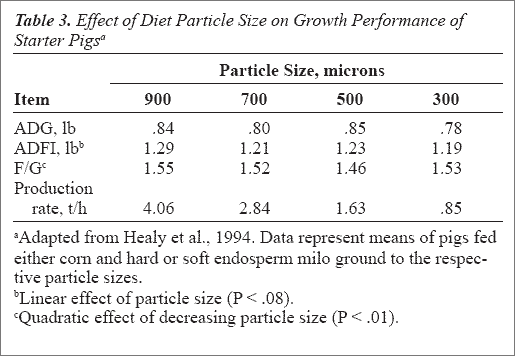The Effects of Diet Particle Size on Animal Performance
The Effects of Diet Particle Size on Animal Performance - Part 1
Cereal grains are the primary energy source in swine and poultry diets. Therefore, not only must producers be concerned about the composition of the grain, but also how it is processed so the animal may fully utilize the nutrients.
Since feed represents 65 to 75 percent of overall production costs in a swine or poultry operation, improving the efficiency of feed utilization will have a tremendous impact on the cost of production. Nearly all feed ingredients will be subjected to some type of particle size reduction.
Particle size reduction increases the surface area of the grain, thus allowing for greater interaction with digestive enzymes. It also improves the ease of handling and the mixing characteristics. However, fine grinding will increase the energy costs of feed processing and may result in feed bridging, dust problems, and increase the incidence of gastric ulcers in swine. Therefore, the increased costs of fine grinding must be offset by improved feed conversion.
Particle Size and Pig Performance: In the past, there has been confusion regarding the optimum particle size in swine diets. This was a result of broad generalizations classifying dietary particle size. In the past, terms like fine, medium, and coarse were used to define particle size. Recently, a more precise classification of determining particle size has been developed based on the mean geometric diameter of particles measured in microns and the geometric mean standard deviation of the particles or their distribution (ASAE 1973). These measurements allow more precise definition of particle size and allow us to make specific recommendations to optimize swine performance.
Complicating the data available on the effects of particle size on pig performance are the interactions between age of the pig, grain type, and particle size. In general, it appears the young pig does a better job of chewing its feed than growing-finishing hogs. The greatest potential for fine grinding to improve feed efficiency will be for finishing pigs. However, fine grinding or rolling will improve feed efficiency regardless of age. A study conducted at Kansas State University demonstrates the effects of particle size on starter pig performance. In the study, 192 pigs (initial weight 13 to 18 pounds) were fed either corn- or sorghum-based diets (Table 1).

The grains were either processed through a hammermill equipped with an 1/8-inch (539 to 624 microns) or 1/4-inch (722 to 877 microns) screen. Each grain was rolled either fine (822 to 885 microns) or coarse (1,147 to 1,217 microns) by adjusting the roller gap and feeding rate.
As expected, fine grinding or rolling reduced mean particle size of the diet. Although the differences in particle size did not affect average daily gain (ADG), feed efficiency (feed/gain) was improved by either fine grinding or rolling (Table 1). By pooling the data across grain type and processing method and classifying it based only on particle size, the improved feed efficiency appears to be a result of improved nutrient digestibility (Table 2).

Recently, Healy et al. (1994) evaluated growth performance of pigs weaned at 21 days of age and fed starter diets in which the grain (corn and hard or soft endosperm milo) was ground to 900, 700, 500, or 300 microns (Table 3). These results confirm that reducing grain particle size had little improvement on ADG. Average daily feed intake (ADFI) decreased (linear, P less than .08) as particle size of the diet was reduced. Feed efficiency (F/G) improved then became poorer (quadratic, P less than .01) as particle size decreased suggesting an optimum particle size between 500 and 700 microns.

Pigs fed grain ground to 500 microns had a 6 percent improvement in feed efficiency compared to those pigs fed diets containing grain ground to 900 microns. However, production rate (tons of grain ground per hour) was reduced 43 percent by decreasing particle size from 700 to 500 microns. Also important is the numerical trend for decreased ADG and ADFI and poorer F/G of pigs fed the diets containing grain ground to 300 microns. The decision on optimum diet particle size needs to include assessment of improvements in feed efficiency versus reductions in milling production. These and other data suggest a dietary particle size of approximately 700 microns to optimize both pig performance and milling efficiency.




